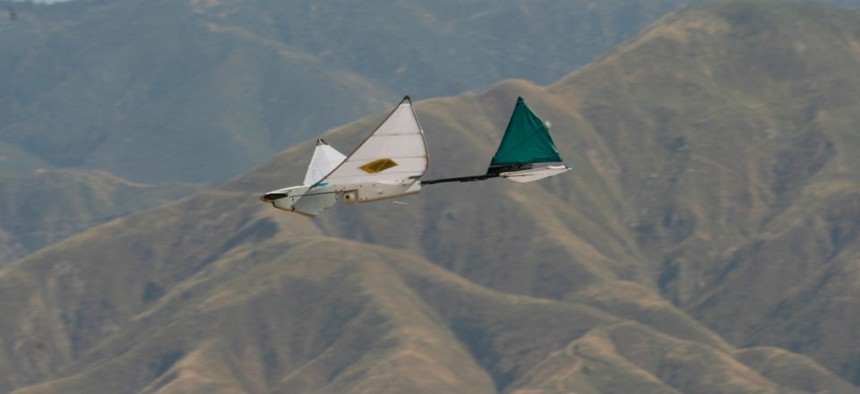Drone Testing Could Soon Come to an Airfield Near You

The SkySeer is used by the Los Angeles Police Department. Damian Dovarganes/AP file photo
The FAA has tapped six operators to examine the widespread use of remotely-piloted aircraft in domestic airspace.
Following a 10-month evaluation process, the Federal Aviation Administration on Monday announced it had picked six entities across the country to research and test the use of remotely-piloted aircraft in domestic airspace.
While the potential widespread use of drones has alarmed privacy advocates and some safety officials, Transportation Secretary Anthony Foxx said in a statement, “These test sites will give us valuable information about how best to ensure the safe introduction of this advanced technology into our nation’s skies.”
A September report by the department’s Volpe National Transportation Systems Center, conducted at the request of the Air Force, estimated that civilian agencies at all levels of government will operate as many as 70,000 unmanned systems in domestic airspace by 2035, many for emergency response. What’s more, the center predicts that as the market for unmanned systems evolves, commercial drone sales will approach 250,000 by 2035, of which 175,000 will be in the commercial marketplace.
“Safety continues to be our first priority as we move forward with integrating unmanned aircraft systems into U.S. airspace,” said FAA Administrator Michael Huerta. “We have successfully brought new technology into the nation’s aviation system for more than 50 years, and I have no doubt we will do the same with unmanned aircraft.”
The six operators include:
- University of Alaska. The university will operate multiple test sites, including in Hawaii and Oregon, in seven climatic zones. The research plan includes development of standards for unmanned aircraft categories, state monitoring and navigation. Alaska also plans to work on safety standards.
- State of Nevada. The state will concentrate on UAS standards and operations as well as operator standards and certification requirements. Nevada will examine how air traffic control procedures will evolve with the introduction of UAS into the civil environment and how these aircraft will be integrated with NextGen.
- New York’s Griffiss International Airport. Griffiss International plans to work on developing test and evaluation as well as verification and validation processes under FAA safety oversight. Research will focus on sense-and-avoid capabilities and the complexities of integrating unmanned systems into the congested, northeast airspace.
- North Dakota Department of Commerce. The state agency plans to develop airworthiness essential data and validate high reliability link technology. It will also conduct human factors research. North Dakota’s application was the only one to offer a test range in the temperate (continental) climate zone and included a variety of airspace, which will benefit multiple users.
- Texas A&M University, Corpus Christi. The university will develop system safety requirements.
- Virginia Polytechnic Institute and State University. Virginia Tech plans to conduct failure mode testing and identify and evaluate operational and technical risks areas. The school’s proposal includes test site range locations in both Virginia and New Jersey.
The six were selected among 25 proposals from 24 states.






